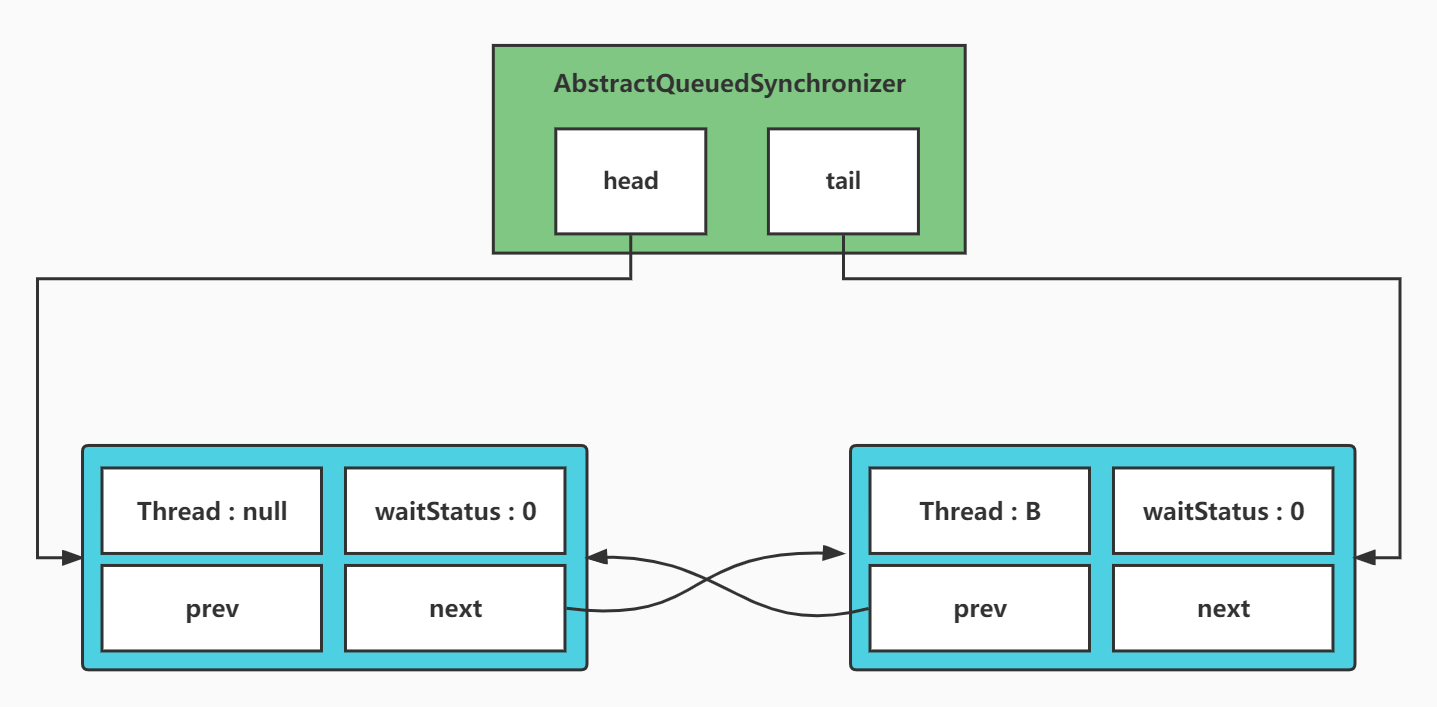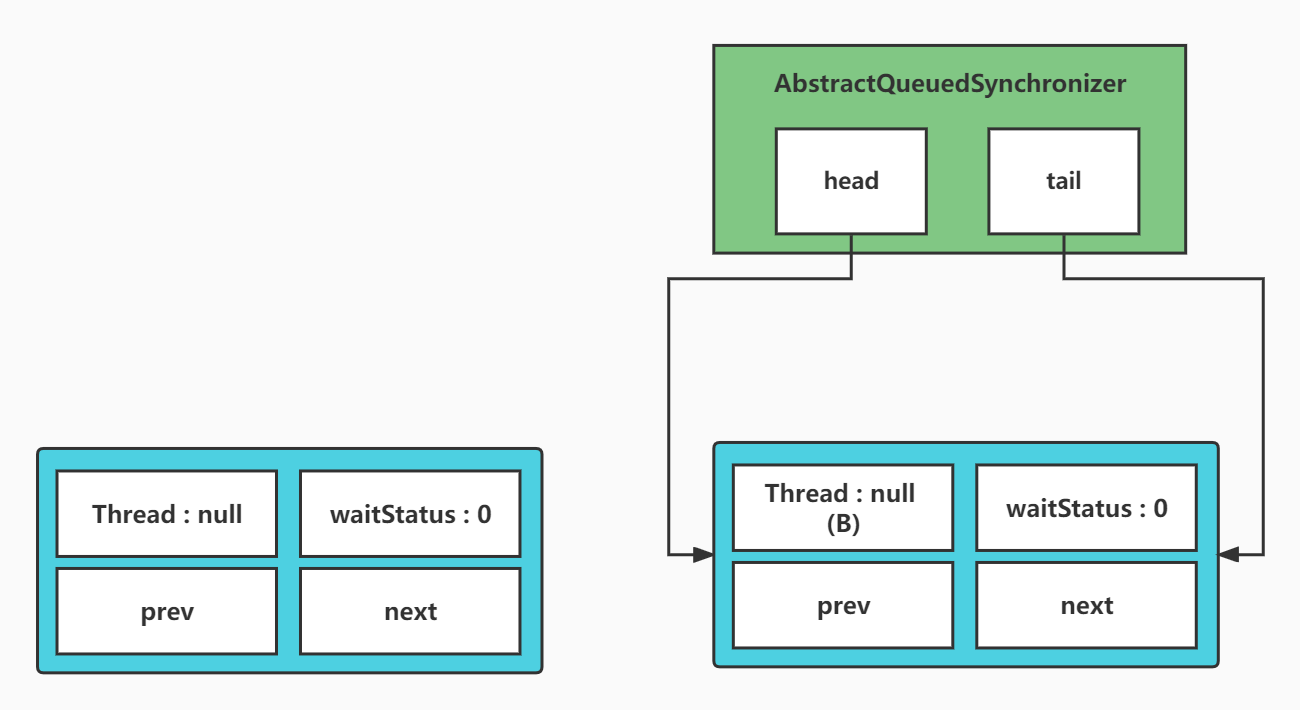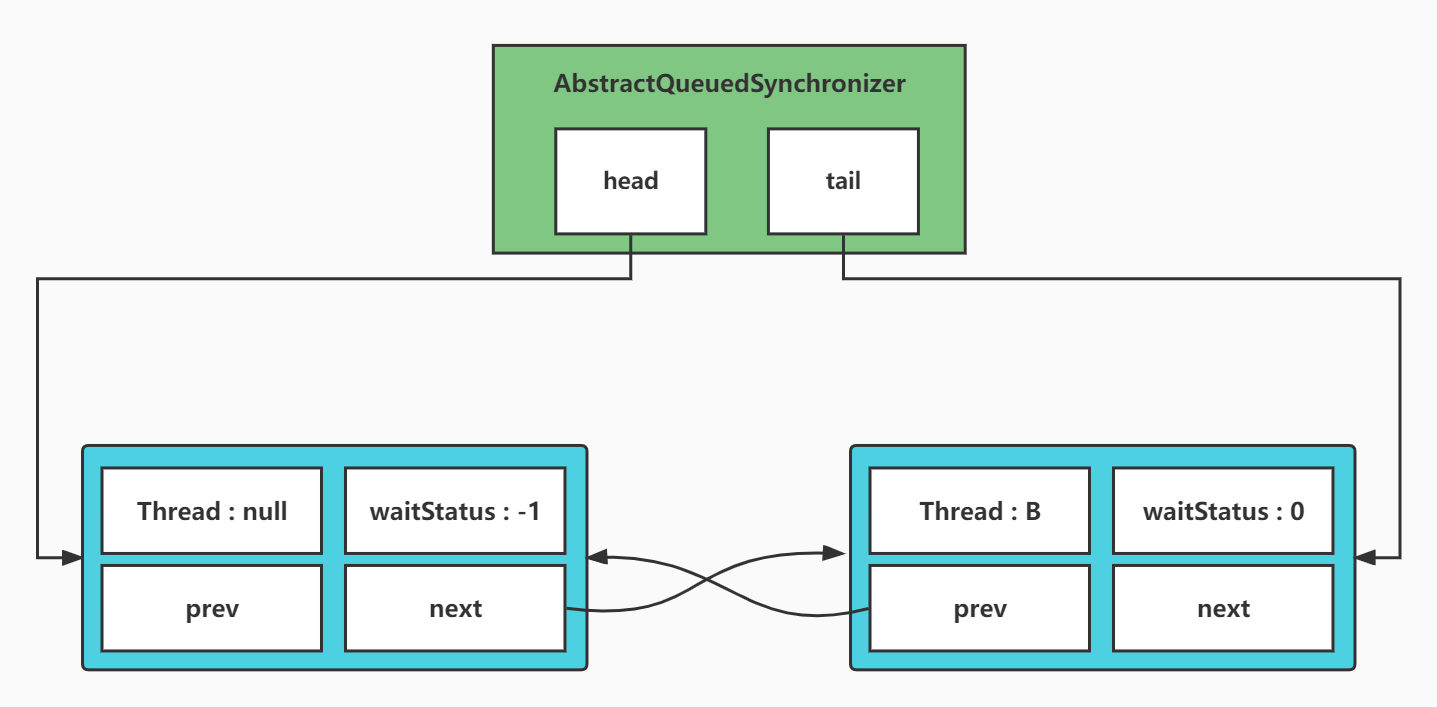? 优质资源分享 ?
| 学习路线指引(点击解锁) | 知识定位 | 人群定位 |
|---|---|---|
| ? Python实战微信订餐小程序 ? | 进阶级 | 本课程是python flask+微信小程序的完美结合,从项目搭建到腾讯云部署上线,打造一个全栈订餐系统。 |
| ?Python量化交易实战? | 入门级 | 手把手带你打造一个易扩展、更安全、效率更高的量化交易系统 |
ReentrantLock 1
这篇还是接着ReentrantLock的公平锁,没看过第0篇的可以先去看上一篇https://blog.csdn.net/sunankang/p/16456342.html
这篇就以问题为导向,先提出问题,然后根据问题去看代码
确保能唤醒排队的线程?
A,B两线程,A线程执行完业务释放锁过程中B线程添加进了链表,如何保证B线程能正常醒来
现在假设A线程走完tryAcuqire后获取到锁,执行业务代码,最后unlock() tryAcquire代码就不进去看了,上篇讲过了 现在只需关注两个点
lock方法中的acquireQueued 用来park
unlock方法中的release用来unpark
首先来看park的条件是啥
public final void acquire(int arg) {
if (!tryAcquire(arg) && acquireQueued(addWaiter(Node.EXCLUSIVE), arg))
selfInterrupt();
}
进入acquireQueued方法
final boolean acquireQueued(final Node node, int arg) {
boolean failed = true;
try {
boolean interrupted = false;
for (;;) {
final Node p = node.predecessor();
if (p == head && tryAcquire(arg)) {
setHead(node);
p.next = null; // help GC
failed = false;
return interrupted;
}
if (shouldParkAfterFailedAcquire(p, node) &&
parkAndCheckInterrupt()) //在这里进行的park
interrupted = true;
}
} finally {
if (failed)
cancelAcquire(node);
}
}
也就是shouldParkAfterFailedAcquire 如果这个方法返回true,才会去park
private static boolean shouldParkAfterFailedAcquire(Node pred, Node node) {
int ws = pred.waitStatus;
if (ws == Node.SIGNAL)
return true;
if (ws > 0) {
do {
node.prev = pred = pred.prev;
} while (pred.waitStatus > 0);
pred.next = node;
} else {
compareAndSetWaitStatus(pred, ws, Node.SIGNAL);
}
return false;
}
现在假设第一种情况,首次进入这个shouldParkAfterFailedAcquire方法的时候,A线程就进入unlock方法了 那么此时节点状态如下图

public final boolean release(int arg) {
if (tryRelease(arg)) {
Node h = head;
//主要看这段代码
if (h != null && h.waitStatus != 0)
unparkSuccessor(h);
return true;
}
return false;
}
那么h!=null进入,但是头节点的waitStatus还是0,所以不走unpark,A线程结束
A线程结束了谁来唤醒B线程呢? 回到acquireQueued方法
final boolean acquireQueued(final Node node, int arg) {
boolean failed = true;
try {
boolean interrupted = false;
for (;;) {
final Node p = node.predecessor();
if (p == head && tryAcquire(arg)) {
setHead(node);
p.next = null; // help GC
failed = false;
return interrupted;
}
if (shouldParkAfterFailedAcquire(p, node) &&
parkAndCheckInterrupt())
interrupted = true;
}
} finally {
if (failed)
cancelAcquire(node);
}
}
因为第一次进入shouldParkAfterFailedAcquire方法中,最后走到else代码块,我们假设没有发生冲突,修改成功
A线程执行完了unlock,而此时锁的状态值为0,没有被持有的状态,最外层的for(;;)让代码又重新跑了一遍
第二次的时候if (p == head && tryAcquire(arg)) 这个if就会进入,因为现在已经没有其他线程在持有锁了,所以tryAcquire尝试获取锁成功,返回ture
private void setHead(Node node) {
head = node;
node.thread = null;
node.prev = null;
}
在setHead方法中将当前节点,咱们这个例子中也就是B节点,设置为head,之后清空上个引用和当前引用的线程
最后清除上个节点对B节点的引用,此时节点关系如下

而原来的头节点没有任何引用,等待GC即可,也可以看到在代码p.next = null; // help GC 这段旁边写的注释 帮助GC
之后将失败状态设置为false,返回是否被打断的变量,lock方法结束,
现在来假设在shouldParkAfterFailedAcquire方法中修改成功,但此时的A线程还没有走到unlock,当B线程马上要开始走parkAndCheckInterrupt方法开始park的时候,时间片用完的情况
final boolean acquireQueued(final Node node, int arg) {
boolean failed = true;
try {
boolean interrupted = false;
for (;;) {
final Node p = node.predecessor();
if (p == head && tryAcquire(arg)) {
setHead(node);
p.next = null; // help GC
failed = false;
return interrupted;
}
if (shouldParkAfterFailedAcquire(p, node) &&
//====假设此时B线程在这里=====
parkAndCheckInterrupt())
interrupted = true;
}
} finally {
if (failed)
cancelAcquire(node);
}
}
此时节点关系如下

A线程的unlock就可以进入unparkSuccessor
public final boolean release(int arg) {
if (tryRelease(arg)) {
Node h = head;
if (h != null && h.waitStatus != 0)
unparkSuccessor(h);
return true;
}
return false;
}
private void unparkSuccessor(Node node) {
int ws = node.waitStatus;
if (ws < 0)
compareAndSetWaitStatus(node, ws, 0);
Node s = node.next;
if (s == null || s.waitStatus > 0) {
s = null;
for (Node t = tail; t != null && t != node; t = t.prev)
if (t.waitStatus <= 0)
s = t;
}
if (s != null)
LockSupport.unpark(s.thread);
}
第一个if判断为true,尝试修改状态为0 (这里没看懂为什么是尝试修改)
if (s == null || s.waitStatus > 0) 这个判断我们是不进入的,注意unparkSuccessor这个方法的node参数是head节点,而不是我们的B节点,所以继续执行下面的if判断
s就是B节点,在B线程park前唤醒,B线程再走到park的时候是不会再进行park的,直接返回,方法结束
真的公平吗?
A线程在运行,B线程初始化链表中的过程中,A线程运行完成,释放锁,C线程进入
我们只需要看线程B初始化链表的情况即可
addWaiter中enq方法
private Node enq(final Node node) {
for (;;) {
Node t = tail;
if (t == null) { // Must initialize
if (compareAndSetHead(new Node()))
//假设线程B走到这里时间片用完,还没来得及设置tail
tail = head;
} else {
node.prev = t;
if (compareAndSetTail(t, node)) {
t.next = node;
return t;
}
}
}
}
那么此时线程A解锁了,线程C调用lock方法
protected final boolean tryAcquire(int acquires) {
final Thread current = Thread.currentThread();
int c = getState();
if (c == 0) {
if (!hasQueuedPredecessors() &&
compareAndSetState(0, acquires)) {
setExclusiveOwnerThread(current);
return true;
}
}
else if (current == getExclusiveOwnerThread()) {
int nextc = c + acquires;
if (nextc < 0)
throw new Error("Maximum lock count exceeded");
setState(nextc);
return true;
}
return false;
}
在tryAcquire方法的hasQueuedPredecessors方法中
public final boolean hasQueuedPredecessors() {
Node t = tail;
Node h = head;
Node s;
return h != t &&
((s = h.next) == null || s.thread != Thread.currentThread());
}
此时tail还是null,而head已经被线程B设置了一个空Node,h!=t为true,h也只是一个空Node,所以(s = h.next) == null为true,整体返回true,外层取反为false,退出tryAcquire方法去入队列
那么入队列会破坏队列的初始化或者C线程变成第一个排队的节点吗?,注意咱们现在假设的线程B还没有获取到cpu的调用,还是停在 tail = head;代码执行前
线程C执行addWaiter方法
private Node addWaiter(Node mode) {
Node node = new Node(Thread.currentThread(), mode);
// Try the fast path of enq; backup to full enq on failure
Node pred = tail;
if (pred != null) {
node.prev = pred;
if (compareAndSetTail(pred, node)) {
pred.next = node;
return node;
}
}
enq(node);
return node;
}
这个时候tail还是空,进入enq方法
private Node enq(final Node node) {
for (;;) {
Node t = tail;
if (t == null) { // Must initialize
if (compareAndSetHead(new Node()))
tail = head;
} else {
node.prev = t;
if (compareAndSetTail(t, node)) {
t.next = node;
return t;
}
}
}
}
首先第一个判断是会进入的,这个时候tail还是空,但是if (compareAndSetHead(new Node()))方法不会成功,来看看代码
private final boolean compareAndSetHead(Node update) {
//注意第三个参数 null
return unsafe.compareAndSwapObject(this, headOffset, null, update);
}
判断的是head为null的时候才会进行修改,所以线程C没有修改成功,那么会一直在for(;;)中循环,直到线程B初始化完空的头节点,也就是执行tail = head;这段代码
如果线程B走完了 tail = head;没来得及进行第二次循环添加B节点的时候,线程A解锁了,线程C进来了呢
还是在tryAcquire方法的hasQueuedPredecessors中
public final boolean hasQueuedPredecessors() {
Node t = tail;
Node h = head;
Node s;
return h != t &&
((s = h.next) == null || s.thread != Thread.currentThread());
}
这个时候第一个h!=t就是false,因为B线程已经将head和tail的引用指向同一个空节点了,返回false
protected final boolean tryAcquire(int acquires) {
final Thread current = Thread.currentThread();
int c = getState();
if (c == 0) {
//因为返回false,取反则进行获取锁的操作
if (!hasQueuedPredecessors() &&
compareAndSetState(0, acquires)) {
setExclusiveOwnerThread(current);
return true;
}
}
else if (current == getExclusiveOwnerThread()) {
int nextc = c + acquires;
if (nextc < 0)
throw new Error("Maximum lock count exceeded");
setState(nextc);
return true;
}
return false;
}
C线程直接获取锁去运行代码了,所以ReentrantLock的公平锁其实并不是绝对的公平
-
__EOF__
- 本文作者: Jame
- 本文链接: https://blog.csdn.net/sunankang/p/16458795.html
- 关于博主: 评论和私信会在第一时间回复。或者直接私信我。
- 版权声明: 本博客所有文章除特别声明外,均采用 BY-NC-SA 许可协议。转载请注明出处!
- 声援博主: 如果您觉得文章对您有帮助,可以点击文章右下角【推荐】一下。
- 本文作者: Jame
转载请注明:xuhss » ReentrantLock 公平锁源码 第1篇